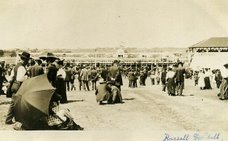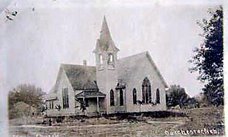 Can you imagine oil prospectors drilling in Saline County?
Can you imagine oil prospectors drilling in Saline County?It has happened before.
As petroleum power became a reality early last century, there was active exploration for oil in the Dorchester area.
Pictured at the right is an oil well drilled just outside Dorchester in August of 1925. The well proved unsuccessful and was discontinued in 1927. But the search for an oil field continued for several years, including a 3,500-foot prospect well on the William Mumma farm in 1933.
You may be asking: Nebraska an oil state? According to the Nebraska State Historical Society, the first publicized report of oil in Nebraska was an 1883 newspaper account of a "vein of petroleum" discovered in Richardson County. Over the next 57 years, the search for oil consumed thousands of dollars, and hundreds of wells were drilled throughout Nebraska. Traces of oil were reported at various locations across the state, but Nebraska did not have a producing well until 1940.
In 1940, the Pawnee Royalty Company reported that one of their wells began producing and averaged 169 barrels daily for the first 60 days. The well easily qualified for a $15,000 bonus offered by the Nebraska Legislature for the first oil well in the state to produce at least 50 barrels daily for 60 consecutive days. Interestingly, the well was located about five miles east of the "vein of petroleum" reported in 1883.
Nebraska's crude oil production peaked in 1963. So it's clear that with high oil prices, our state offers oil resources if the Biden administration stays out of producers' way.
Here are the Nebraska counties where most production occurs today. Nebraska's oil production is now largely centered in the southwestern panhandle, although a sustained resurgence in oil prices would certainly rekindle interest in continuing oil production in other areas of the state, if it exists.
We are interested in what our readers know regarding Nebraska's oil production history and capacity.
%20(1).png)

















































Despite my environmental concerns, I have reached the point where an oil discovery on my "eighty” would be a relief! For more information on oil drilling in Nebraska, read “Mari Sandoz: Story Catcher of the Plains” by Helen Stauffer.
ReplyDeleteEnviro concerns? C'mon...
ReplyDeleteOil is the foundation of civilized life. Almost every aspect of modern living involves petro chemicals. Fuel, electricity, plastics, rubber, fertilizers, metal production. Without oil (and the natural gas that accompanies it), we go back to the Stone Age.
Or are we all foolish enough to believe wind power and ethanol (cellulosic or corn based) are gonna save us all? Oh, wait ... we need oil to get those to market, too.
Call Ben Nelson (202.224.6551) and ask him why he opposes drilling in the Alaska Wildlife Reserve. Ask him why he opposes adding 1 million barrels a day of new U.S. oil? (That new supply would replace about 10% of the foreign oil we import right now.) And when his little staffer starts talking about ethanol, ask him how those corn prices are treating Nebraska livestock producers. And when he starts babbling about the years it will take to get a drop from ANWR, remind him he first voted against drilling in Alaska in early 2002.
It sounds like you have a firm pulpit and position in which to stand upon. I believe you would make an effective advocate and lobbyist for changing Washington. Please keep us updated on your efforts.
ReplyDeleteRegarding Ben Nelson's vote to stop more domestic oil production and his coddling of the environmentalists, he can also be e-mailed by going to this website ... http://bennelson.senate.gov/contact/email.cfm
ReplyDeletenelson should be ashamed of himself. always trying to have it both ways - at the mere cost of philosophy and integrity.
ReplyDeleteI'm no engineer, but is there really any potential for oil under most of Nebraska? Last I checked we sit over a huge underground ocean called the Ogallala Aquifer.
ReplyDeleteThere's supposed to be an oil well that was drilled and capped in the '50's along Turkey Creek, east of the HWY 15 bridge.
ReplyDeleteBob is correct about the Ogallala aquifer. The aquifer stretches from South Dakota to Texas with 66%of the water located in Nebraska. Out of eight states, Nebraska is home to the largest section of the aquifer. However, beware of T. Boone Pickens. (An Oklahoman who has been a Texas oilman since the 1950’s.) Pickens wants to take the water from the Ogallala Aquifer and pump about 200,000 acre feet of groundwater annually to El Paso, Lubbock, San Antonio, or Dallas-Fort Worth - for a price, of course. This price would depend on how far the water needs to go. The Aquifer is being depleted at a rate of 12 billion cubic meters (420 billion ft3) per year, amounting to a total depletion to date of a volume equal to the annual flow of 18 Colorado Rivers. Some estimates say it will dry up in as little as 25 years. (Sources: Salon. Com., Wikipedia, Watch Your Assets)
ReplyDeletePeople need to realize that the monies from these grants are just not thrown at the communities with no guidelines.
ReplyDeleteIn many cases the grants require matching funds. With the construction costs of projects these days it would require many dollars for small projects.
The Village of Dorchester has looked into these grants many times in the past.
The water system that was repaired a few years back did not qualify for funding becasue it would have required the installation of water meters. Many members of this village did not want the water meters and this is why the village ended up with the whole cost of this project.
The issue of housing is another. Twice in the last 15 years the Village of Dorchester has had town meetings and hired an engineer to come in and look at what was going to be good for Dorchester. It was shown that there was a lack of need for any type of elderly or low income housing. Blue Valley had a project on the North side of town and couldnt keep it filled with elderly people. The elderly did not want to move out of thier homes. At one time there was more low income people living in these units then there was elderly.
We all know what many of the citizens feel about the low income and disadvanted in this community...........it is evident as to the comments that are posted to this blog sight. Many of these people want the perfect little community without any of the problems.
Hire a person or firm to write grants for the community. See what happens. I would venture to guess that within two years the people would say that it wasnt worth the money because the Village is not getting any.
If anybody tries drilling in my fields or pasture I'll give them a pocket full of lead................ we need to stick it to the big oil boys ......... use more ethanol .............
ReplyDeleteThurston Howell the Third is quit correct. It was just south of my great grandfather's farm. Several people in the community, and adjacent farms invested in it. As I recall, it only produced an estimated 30 barrels a day.........not profitable back then. This is the well on the Mumma farm spoken of in the main article. It was in the late 40's ro early 50's, not the thirties. My grandparents had just moved there, and I believe if you want the real skinny on this, you should ask my dad! He remembers it.
ReplyDeleteBut I could be mistaken on the time frame, it was a few years before my birth, but I remember famliy speaking of it.
JR Wolfe
York, Nebraska
I have 2 comments.
ReplyDelete1.) Someone responded to the comments above about grants, water meters, etc. on the story about economic development grants. Whoever that person is needs to run for village board. I'm 100% serious. You are RIGHT ON.
2.) JR Wolfe, if what you and the Thurston Howell III says is true, someone seriously needs to think about re-starting that oil well by Turkey Creek. It will cost some money to get the "wildcaters" out here to get the well going again, but maybe we could get an investment group going in town and could profit share from the oil that comes from the well. 30 barrels of oil a day would be a $3800-$4000/day profit at today's oil prices. I'd much rather invest in a Saline County oil well than an ethanol plant. Despite what Dick says, oil will be around long after ethanol!
I second that, baby. Let's get that thing pumping oil again!!
ReplyDeleteTalk to my dad, I am sure he would be gung ho to start drilling! We need to do it all. Bio fuel, electric, wind, you name, and drill for oil here! We need to send those fellows in the Middle East a message.........lump it!
ReplyDeleteJR Wolfe
HA! So instead of leveraging funding for assistance with the water project, the village decided to let every village tax payer foot the entire bill for water improvements. This is because they didn't want to implement the installation of water meters? Welcome to the 21st century!
ReplyDeleteWas anyone else aware of this? I for one would be willing to pay for the amount of water that I use. That is what the meters are for. Right now the "little old lady" that only uses 1000 gallons pays the same as a family that wastes 10,000 gallons a month.
And yet, when it comes to paying for a water project they both get it socked to them because the cost is assessed to them through the tax levy.
Now that's leadership.
Anonymous -June 6, 2008 9:18 AM
ReplyDeleteYou are not only a good writer, but also a progressive thinker.
Back in the early "80's" when I was farming the family farm, an oil company had a major survey of the area. Those of you in your thirties should remember the machines that rattled the ground, and the vibration it caused. They had sensors every quarter mile. They know there is oil there, and at $139 a barrel, it would be profitable now.
ReplyDeleteJR Wolfe
Oil companies would never waste their time with wells that produce 30 barells/day. The landowner with support from some local investors would be the only way to make this happen.
ReplyDeleteThe Times should find out whose property this capped well is on and see if they're interested in such a project.
to the people who have the answers to the city's problems...did you run for the board??
ReplyDeleteAs for the old ladies that that only use a thousand gallons a month.......drive around and see how many of these poor old ladies have sprinkler systems and water more of the road than the grass.
its obvious there are people out there who dont have a clue how Nebraska govt operates. And these are the same people who sat at home when there were town hall meetings on the water system, but can complain now.
As many complainers we have in town, six names on the ballot seems awfully short.
Considering you cannot tell where the mud streets end and yards begin, if they are watering the street, I blame that on local leadership as well.
ReplyDeleteAnd if they are only using 1000 gallons a month with the watering of yards, than they must not be using any water for bathing or toilets.
Its obvious that people on the village board and those that serve in ancillary positions "don't have a clue on how Nebraska govt operates". Bring on November!
To bring on November,
ReplyDeleteI agree, thats just what this town needs, a bunch of people who dont have a clue. Lets bring in a bunch of people who have never attended a board meeting and turn them loose spending your money.
If these individuals are so interested in shaping up Dorchester how come they havent been to a town board meeting.
I hope the change in November brings a change to the village government's approach and attitude. New blood will do wonders. It ain't rocket science. It's called caring - or in rougher terms, "giving a crap."
ReplyDeleteThere's also supposed to be an old coal mine somewhere north and west of Wilber. Could be another Saline county energy source.
ReplyDeleteThe coal mine is news to us!
ReplyDeleteThe legend is, it was supposed to be a gravel pit, but they hit coal instead of the valuable gravel they were after, and covered it back up. I really don't know the exact location. Unlike the oil well, this one could be a "rural legend."
ReplyDeleteReference the coal mine, at West Mills, for decades in the 1800's, they mined "soft coal". West Mills is just north and west of the Blue River north of Dorchester. For many years in the 1860's this was also one of the few mills were farmers could bring their grain to be milled, and even sold. Many farmers from York County would take several days to bring their loads of grain to West Mills, then go back with some of their milled grain, and some soft coal.
ReplyDeleteJR Wolfe
JR Wolfe,
ReplyDelete"West of Wilber/Hwy 41" and I thank you for the interesting information on West Mills. Our grandfather was an Aksamit whose relatives owned Zwonechek & Aksamit Milling Co. Many of the older homes in Saline County, including my parent’s house, still have the "old coal room." I also remember the early 80's and the oil companies searching for oil throughout Saline County. Unfortunately, a "strike" was not made. Fortunately, our Okie grandparents left us their mineral rights in O.K. Hope springs eternal!
Děkuji
What a coincidence. An oil pipeline may be located near our area.
ReplyDeletehttp://www.journalstar.com/articles/2008/06/09/news/local/doc484db3cc8cec2856435836.txt
I know there were gold, silver, and chalk mines somewhere between P Hill and Dorchester. Lets meet at The Lodge this weekend and go look for them.
ReplyDeleteLook, our neighbors to the north are getting rich!
ReplyDelete"Oil is Making Millionaires in North Dakota"
http://news.yahoo.com/s/ap/20080630/ap_on_re_us/overnight_millionaires
The house at 208 east 7this for sale look at Zillow
ReplyDeleteThe house at 208 east 7this for sale look at Zillow
ReplyDelete